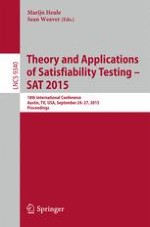This book constitutes the refereed proceedings of the 18th International Conference on Theory and Applications of Satisfiability Testing, SAT 2015, held in Austin, TX, USA, in September 2015. The 21 regular papers, 2 short papers and 7 tool papers presented together with 3 invited talks were carefully reviewed and selected from 70 submissions. The papers address different aspects of SAT, including theoretical advances (exact algorithms, proof complexity, and other complexity issues), practical search algorithms, knowledge compilation, implementation-level details of SAT solvers and SAT-based systems, problem encodings and reformulations, and applications, as well as case studies and reports on insightful findings based on rigorous experimentation.
